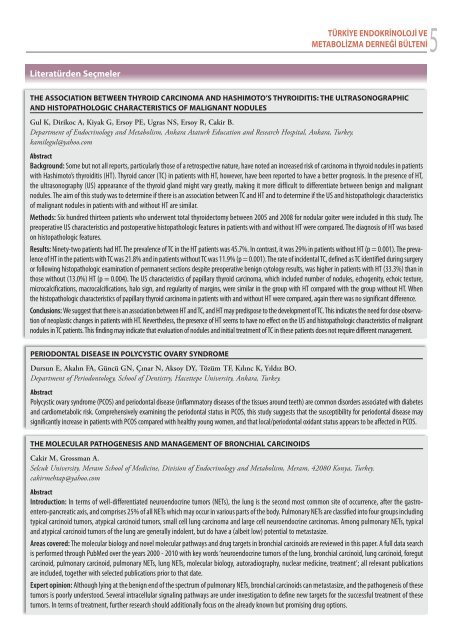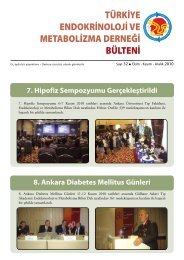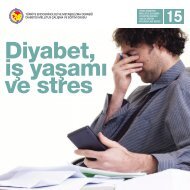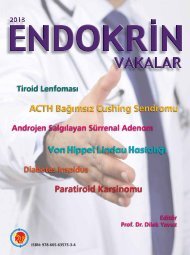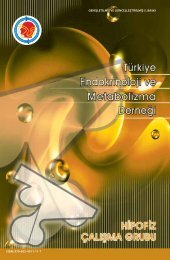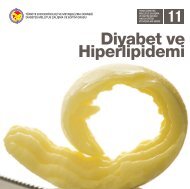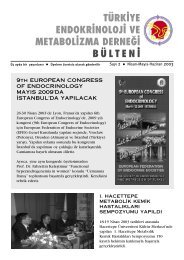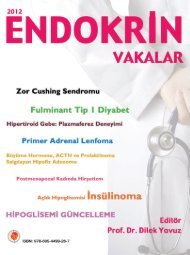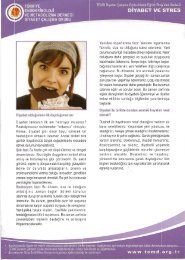türkiye endokrinoloji ve metabolizma derneÄi bülteni t
türkiye endokrinoloji ve metabolizma derneÄi bülteni t
türkiye endokrinoloji ve metabolizma derneÄi bülteni t
- No tags were found...
You also want an ePaper? Increase the reach of your titles
YUMPU automatically turns print PDFs into web optimized ePapers that Google loves.
TÜRKİYE ENDOKRİNOLOJİ VEMETABOLİZMA DERNEĞİ BÜLTENİ5Literatürden SeçmelerTHE ASSOCIATION BETWEEN THYROID CARCINOMA AND HASHIMOTO’S THYROIDITIS: THE ULTRASONOGRAPHICAND HISTOPATHOLOGIC CHARACTERISTICS OF MALIGNANT NODULESGul K, Dirikoc A, Kiyak G, Ersoy PE, Ugras NS, Ersoy R, Cakir B.Department of Endocrinology and Metabolism, Ankara Ataturk Education and Research Hospital, Ankara, Turkey.kamilegul@yahoo.comAbstractBackground: Some but not all reports, particularly those of a retrospecti<strong>ve</strong> nature, ha<strong>ve</strong> noted an increased risk of carcinoma in thyroid nodules in patientswith Hashimoto’s thyroiditis (HT). Thyroid cancer (TC) in patients with HT, howe<strong>ve</strong>r, ha<strong>ve</strong> been reported to ha<strong>ve</strong> a better prognosis. In the presence of HT,the ultrasonography (US) appearance of the thyroid gland might vary greatly, making it more difficult to differentiate between benign and malignantnodules. The aim of this study was to determine if there is an association between TC and HT and to determine if the US and histopathologic characteristicsof malignant nodules in patients with and without HT are similar.Methods: Six hundred thirteen patients who underwent total thyroidectomy between 2005 and 2008 for nodular goiter were included in this study. Thepreoperati<strong>ve</strong> US characteristics and postoperati<strong>ve</strong> histopathologic features in patients with and without HT were compared. The diagnosis of HT was basedon histopathologic features.Results: Ninety-two patients had HT. The prevalence of TC in the HT patients was 45.7%. In contrast, it was 29% in patients without HT (p = 0.001). The prevalenceof HT in the patients with TC was 21.8% and in patients without TC was 11.9% (p = 0.001). The rate of incidental TC, defined as TC identified during surgeryor following histopathologic examination of permanent sections despite preoperati<strong>ve</strong> benign cytology results, was higher in patients with HT (33.3%) than inthose without (13.0%) HT (p = 0.004). The US characteristics of papillary thyroid carcinoma, which included number of nodules, echogenity, echoic texture,microcalcifications, macrocalcifications, halo sign, and regularity of margins, were similar in the group with HT compared with the group without HT. Whenthe histopathologic characteristics of papillary thyroid carcinoma in patients with and without HT were compared, again there was no significant difference.Conclusions: We suggest that there is an association between HT and TC, and HT may predispose to the de<strong>ve</strong>lopment of TC. This indicates the need for close observationof neoplastic changes in patients with HT. Ne<strong>ve</strong>rtheless, the presence of HT seems to ha<strong>ve</strong> no effect on the US and histopathologic characteristics of malignantnodules in TC patients. This finding may indicate that evaluation of nodules and initial treatment of TC in these patients does not require different management.PERIODONTAL DISEASE IN POLYCYSTIC OVARY SYNDROMEDursun E, Akalın FA, Güncü GN, Çınar N, Aksoy DY, Tözüm TF, Kılınc K, Yıldız BO.Department of Periodontology, School of Dentistry, Hacettepe Uni<strong>ve</strong>rsity, Ankara, Turkey.AbstractPolycystic ovary syndrome (PCOS) and periodontal disease (inflammatory diseases of the tissues around teeth) are common disorders associated with diabetesand cardiometabolic risk. Comprehensi<strong>ve</strong>ly examining the periodontal status in PCOS, this study suggests that the susceptibility for periodontal disease maysignificantly increase in patients with PCOS compared with healthy young women, and that local/periodontal oxidant status appears to be affected in PCOS.THE MOLECULAR PATHOGENESIS AND MANAGEMENT OF BRONCHIAL CARCINOIDSCakir M, Grossman A.Selcuk Uni<strong>ve</strong>rsity, Meram School of Medicine, Division of Endocrinology and Metabolism, Meram, 42080 Konya, Turkey.cakirmehtap@yahoo.comAbstractIntroduction: In terms of well-differentiated neuroendocrine tumors (NETs), the lung is the second most common site of occurrence, after the gastroentero-pancreaticaxis, and comprises 25% of all NETs which may occur in various parts of the body. Pulmonary NETs are classified into four groups includingtypical carcinoid tumors, atypical carcinoid tumors, small cell lung carcinoma and large cell neuroendocrine carcinomas. Among pulmonary NETs, typicaland atypical carcinoid tumors of the lung are generally indolent, but do ha<strong>ve</strong> a (albeit low) potential to metastasize.Areas co<strong>ve</strong>red: The molecular biology and no<strong>ve</strong>l molecular pathways and drug targets in bronchial carcinoids are reviewed in this paper. A full data searchis performed through PubMed o<strong>ve</strong>r the years 2000 - 2010 with key words ‘neuroendocrine tumors of the lung, bronchial carcinoid, lung carcinoid, foregutcarcinoid, pulmonary carcinoid, pulmonary NETs, lung NETs, molecular biology, autoradiography, nuclear medicine, treatment’; all relevant publicationsare included, together with selected publications prior to that date.Expert opinion: Although lying at the benign end of the spectrum of pulmonary NETs, bronchial carcinoids can metastasize, and the pathogenesis of thesetumors is poorly understood. Se<strong>ve</strong>ral intracellular signaling pathways are under in<strong>ve</strong>stigation to define new targets for the successful treatment of thesetumors. In terms of treatment, further research should additionally focus on the already known but promising drug options.


